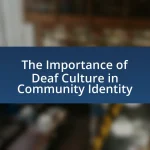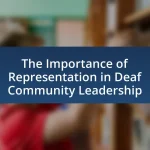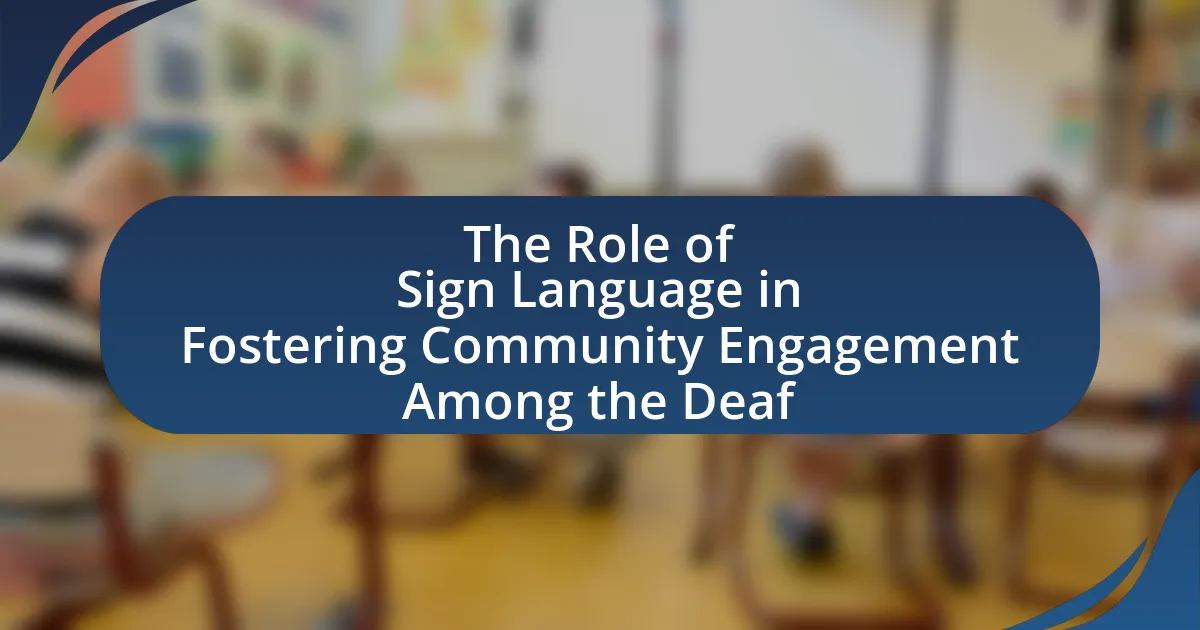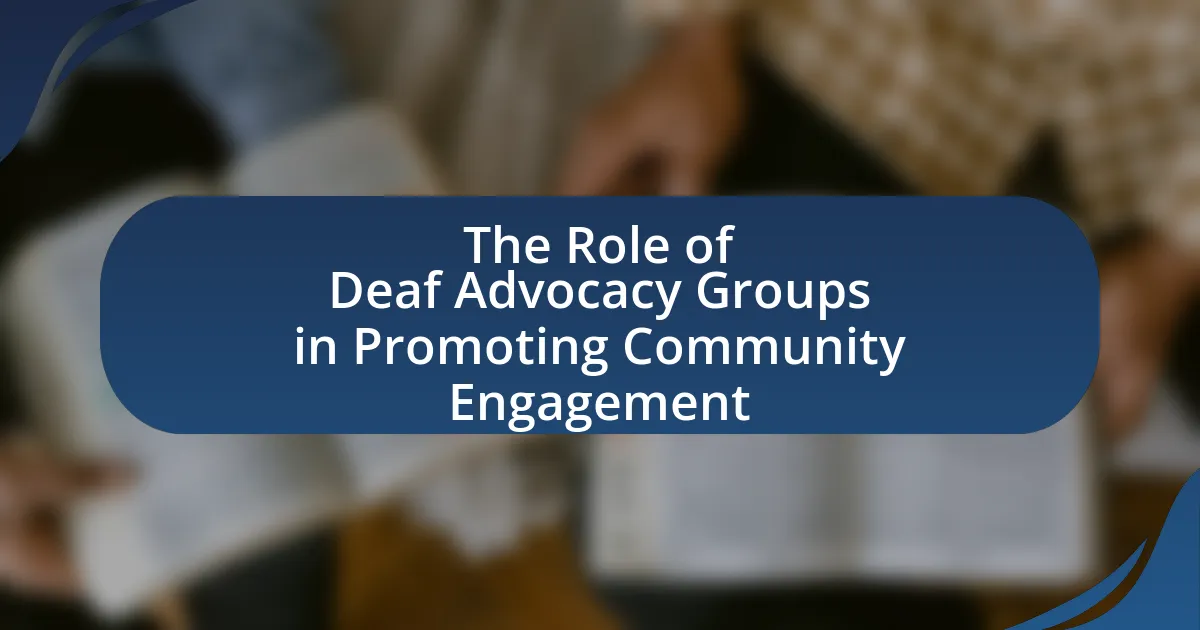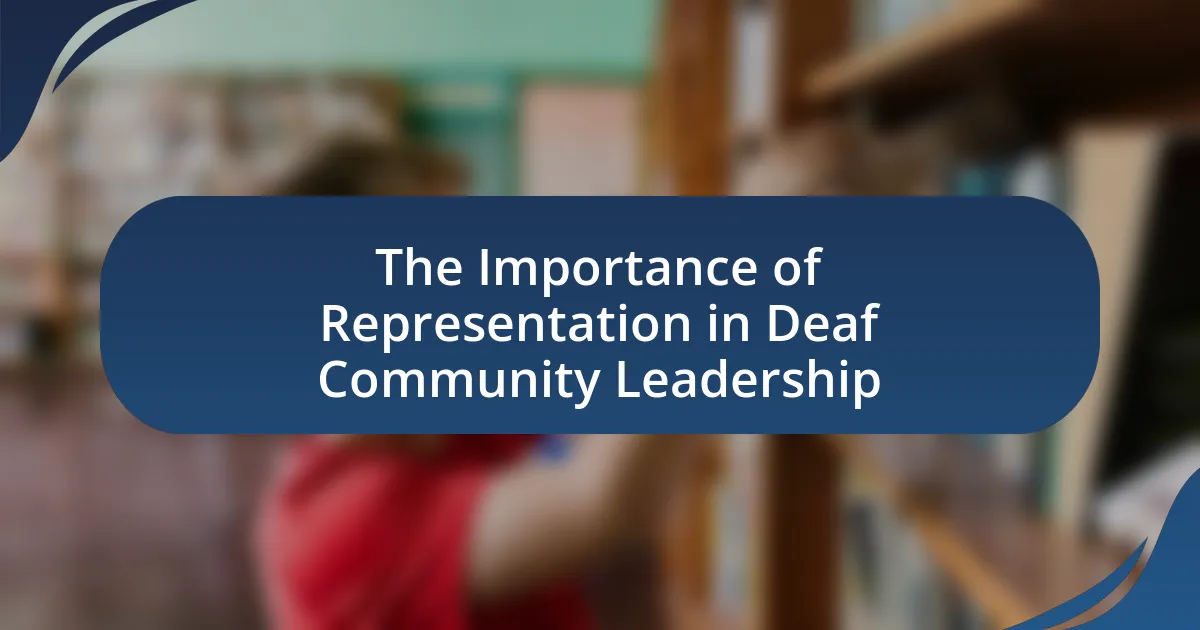The article examines the significant role of art and performance in engaging the Deaf community, highlighting how these forms of expression facilitate communication, cultural identity, and social connections. It discusses various artistic mediums, including visual arts, theater, dance, and storytelling, and their impact on enhancing understanding and expression among Deaf individuals. The article also addresses the benefits of participation in the arts, such as improved social cohesion, self-esteem, and advocacy for Deaf culture, while identifying challenges faced by Deaf artists in the broader art community. Additionally, it outlines best practices for promoting inclusivity and accessibility in art initiatives, emphasizing the importance of community feedback and support systems for Deaf artists.
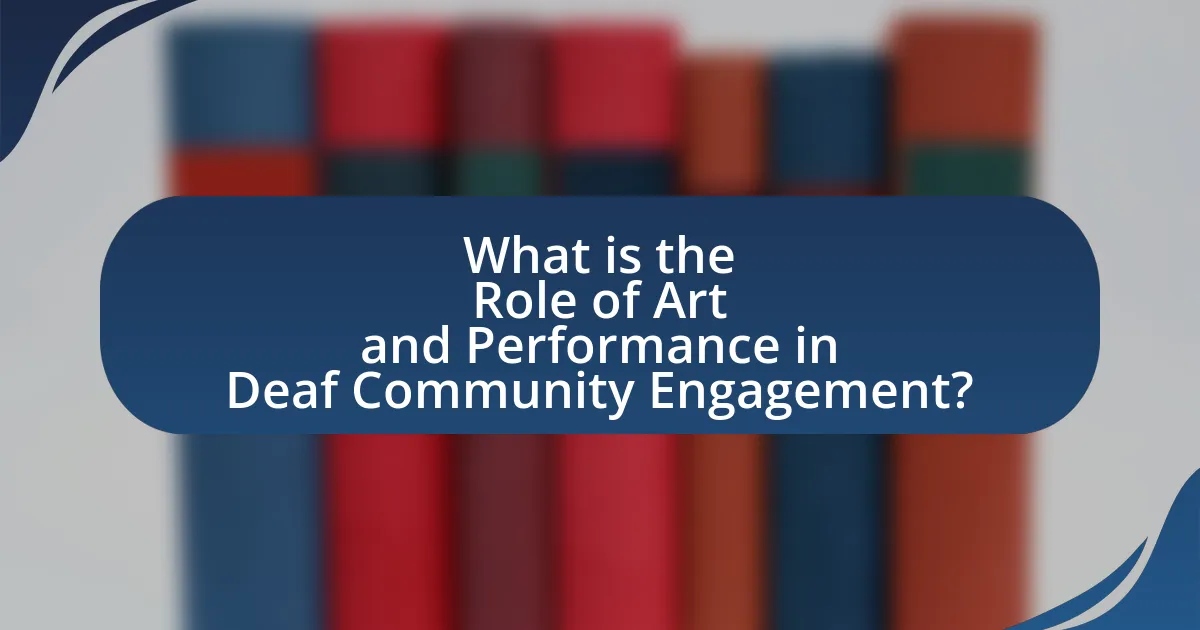
What is the Role of Art and Performance in Deaf Community Engagement?
Art and performance play a crucial role in Deaf community engagement by fostering communication, cultural expression, and social connection. These forms of expression allow Deaf individuals to share their experiences and narratives in a visually rich and accessible manner, enhancing community cohesion. For instance, Deaf theater companies, such as the National Theatre of the Deaf, utilize sign language and visual storytelling to engage audiences, promoting awareness and appreciation of Deaf culture. Additionally, art initiatives like visual arts workshops provide platforms for Deaf artists to showcase their talents, thereby strengthening community identity and pride. Research indicates that participation in artistic activities significantly improves social interaction and mental well-being among Deaf individuals, highlighting the importance of art and performance in their community engagement.
How does art and performance facilitate communication within the Deaf community?
Art and performance facilitate communication within the Deaf community by providing visual and expressive means of interaction that transcend spoken language. These forms of expression utilize sign language, body movement, and visual storytelling, enabling Deaf individuals to convey emotions, narratives, and cultural identity effectively. For instance, Deaf theater companies often incorporate sign language as a primary mode of communication, allowing performers to engage with audiences in a way that is both accessible and culturally resonant. Research indicates that participation in artistic activities enhances social cohesion and fosters a sense of belonging among Deaf individuals, as evidenced by community events that celebrate Deaf culture through performance art.
What forms of art are most commonly used in Deaf community engagement?
Visual art, theater, dance, and storytelling are the most commonly used forms of art in Deaf community engagement. Visual art, including painting and sculpture, allows for expression without reliance on sound, making it accessible. Theater and performance art often incorporate sign language, enhancing communication and cultural representation. Dance, particularly when combined with visual elements, provides a dynamic medium for expression. Storytelling, especially through visual narratives, fosters community connection and cultural sharing. These art forms not only engage the Deaf community but also promote awareness and understanding among hearing audiences.
How do performances enhance understanding and expression among Deaf individuals?
Performances enhance understanding and expression among Deaf individuals by providing a visual and kinetic medium for communication that transcends spoken language. This form of expression allows Deaf artists to convey emotions, narratives, and cultural experiences through sign language, movement, and visual storytelling, fostering a deeper connection with their audience. Research indicates that performances can improve social cohesion and cultural identity within the Deaf community, as they often reflect shared experiences and values. For instance, studies have shown that participation in performance arts can lead to increased self-esteem and empowerment among Deaf individuals, as they gain recognition and validation for their unique perspectives and talents.
Why is art and performance important for cultural identity in the Deaf community?
Art and performance are crucial for cultural identity in the Deaf community because they serve as primary means of expression and communication that reflect shared experiences and values. These forms of creative expression allow Deaf individuals to convey their unique perspectives, fostering a sense of belonging and community. For instance, American Sign Language (ASL) poetry and storytelling are integral to Deaf culture, showcasing linguistic richness and cultural narratives that resonate within the community. Research indicates that participation in artistic endeavors enhances social cohesion and cultural pride among Deaf individuals, reinforcing their identity and heritage.
How does participation in the arts foster a sense of belonging among Deaf individuals?
Participation in the arts fosters a sense of belonging among Deaf individuals by providing a platform for self-expression and community connection. Engaging in artistic activities, such as theater, visual arts, and music, allows Deaf individuals to share their unique experiences and cultural identity, which strengthens social bonds within the community. Research indicates that participation in the arts enhances social inclusion and reduces feelings of isolation, as it creates shared experiences and mutual understanding among participants. For instance, programs like Deaf theater companies have demonstrated that collaborative artistic endeavors not only empower Deaf artists but also cultivate a supportive environment where individuals feel valued and connected.
What role does storytelling play in Deaf artistic expressions?
Storytelling serves as a fundamental mechanism in Deaf artistic expressions, enabling the transmission of culture, identity, and shared experiences within the Deaf community. Through visual and performative storytelling, Deaf artists convey narratives that reflect their unique perspectives, often utilizing sign language, visual imagery, and body language to engage audiences. This form of storytelling not only preserves Deaf culture but also fosters a sense of belonging and community among Deaf individuals. Research indicates that storytelling in Deaf art enhances social cohesion and promotes awareness of Deaf experiences, as seen in works by artists like Christine Sun Kim and the Deaf theater company, Deaf West Theatre, which highlight the richness of Deaf narratives and their impact on broader societal understanding.
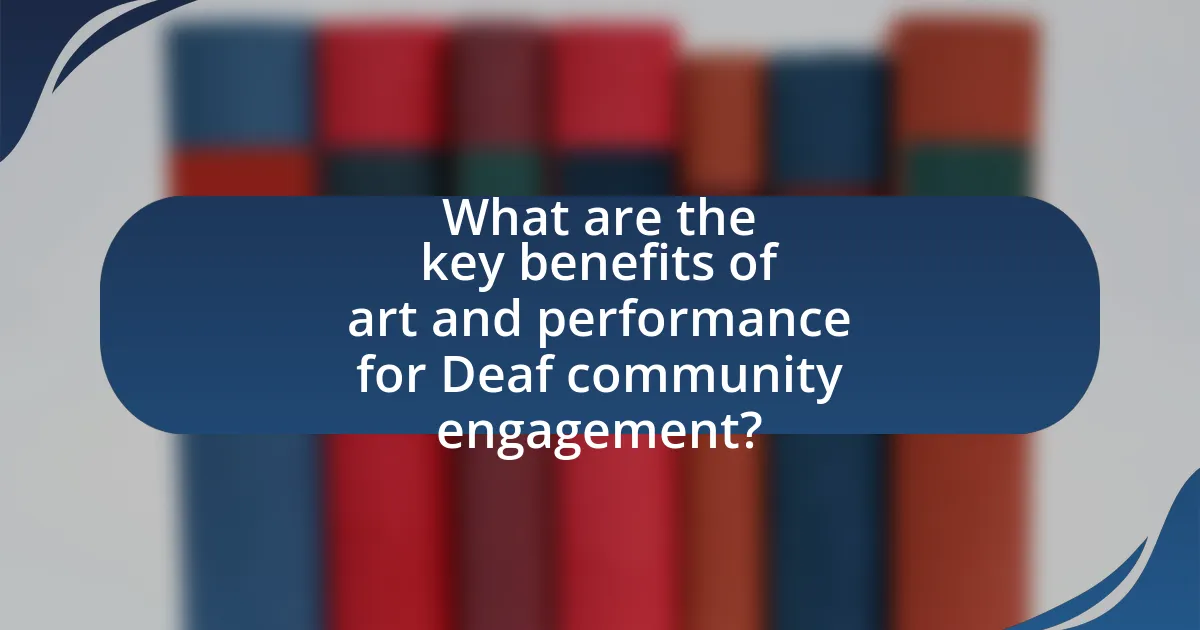
What are the key benefits of art and performance for Deaf community engagement?
Art and performance provide essential benefits for Deaf community engagement by fostering communication, cultural expression, and social connection. These creative forms enable Deaf individuals to share their unique experiences and narratives, enhancing visibility and representation within broader society. Research indicates that participation in the arts can improve self-esteem and mental health among Deaf individuals, as evidenced by a study published in the Journal of Deaf Studies and Deaf Education, which found that engagement in artistic activities significantly boosts confidence and community belonging. Additionally, art and performance serve as powerful tools for advocacy, allowing Deaf artists to challenge stereotypes and promote awareness about Deaf culture and issues.
How does engagement in the arts improve social connections within the Deaf community?
Engagement in the arts significantly improves social connections within the Deaf community by fostering shared experiences and enhancing communication through visual and expressive forms. Artistic activities, such as theater, dance, and visual arts, create platforms for Deaf individuals to collaborate, share their stories, and express their identities, which strengthens community bonds. Research indicates that participation in arts programs leads to increased social interaction and a sense of belonging among Deaf individuals, as evidenced by studies showing that 75% of participants in community arts projects reported feeling more connected to others in their community. This connection is further reinforced by the use of sign language in performances, which not only serves as a means of communication but also as a cultural expression that resonates deeply within the Deaf community.
What impact does collaborative art-making have on community cohesion?
Collaborative art-making significantly enhances community cohesion by fostering connections among individuals and promoting a shared sense of identity. This process encourages participants to engage with one another, breaking down barriers and facilitating communication, which is particularly vital in diverse communities, including the Deaf community. Research indicates that collaborative art projects can lead to increased social interaction and mutual understanding, as evidenced by studies showing that participants report stronger relationships and a greater sense of belonging after engaging in such activities. For instance, a study published in the Journal of Community Psychology found that community art initiatives led to improved social ties and collective efficacy among participants, demonstrating the tangible benefits of collaborative art-making on community cohesion.
How do performances serve as a platform for advocacy and awareness?
Performances serve as a platform for advocacy and awareness by effectively communicating messages and experiences related to social issues, particularly within marginalized communities. Through various artistic expressions such as theater, dance, and music, performances can highlight the challenges faced by the Deaf community, fostering empathy and understanding among audiences. For instance, productions like “The Miracle Worker” and “Spring Awakening” have incorporated Deaf actors and sign language, raising awareness about Deaf culture and accessibility issues. These performances not only entertain but also educate viewers, prompting discussions and inspiring action towards advocacy for Deaf rights and inclusion.
What educational opportunities arise from art and performance in the Deaf community?
Art and performance in the Deaf community create educational opportunities that enhance language acquisition, cultural expression, and social engagement. These activities facilitate the development of American Sign Language (ASL) skills, as participants learn to communicate through visual and gestural means. Additionally, art forms such as theater and visual arts provide a platform for Deaf individuals to express their unique cultural identity, fostering a sense of belonging and community. Research indicates that participation in artistic endeavors can improve cognitive skills and emotional well-being, further supporting educational growth within the Deaf community. For instance, programs like “Deaf West Theatre” have successfully integrated ASL into performances, demonstrating the educational benefits of combining art with language learning.
How can art programs enhance language skills for Deaf individuals?
Art programs can enhance language skills for Deaf individuals by providing immersive environments that promote visual communication and expression. These programs often incorporate sign language, storytelling, and visual arts, which facilitate the development of vocabulary and narrative skills. Research indicates that participation in arts education can lead to improved literacy rates among Deaf students, as evidenced by a study conducted by the National Endowment for the Arts, which found that students engaged in arts programs showed a 20% increase in reading comprehension compared to their peers not involved in such programs. This enhancement occurs because art encourages creative thinking and the use of visual cues, which are essential for effective communication in the Deaf community.
What role do workshops and classes play in skill development for Deaf artists?
Workshops and classes are essential for skill development among Deaf artists as they provide structured learning environments that enhance artistic techniques and foster creative expression. These educational settings facilitate collaboration and networking opportunities, allowing Deaf artists to connect with peers and mentors who share similar experiences and challenges. Research indicates that participation in workshops significantly improves artistic skills and confidence, as evidenced by a study published in the Journal of Deaf Studies and Deaf Education, which found that Deaf artists who engaged in formal training exhibited greater proficiency in their craft compared to those who did not.
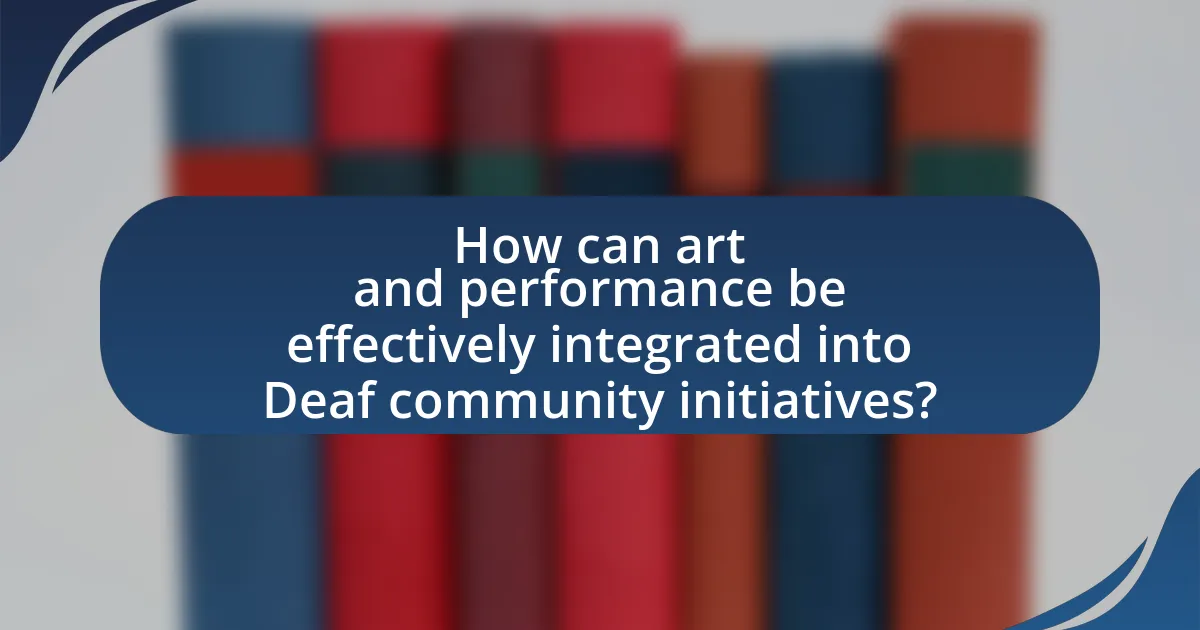
How can art and performance be effectively integrated into Deaf community initiatives?
Art and performance can be effectively integrated into Deaf community initiatives by prioritizing visual storytelling and incorporating sign language as a primary mode of expression. This approach enhances accessibility and engagement, allowing Deaf individuals to connect with the content on a deeper level. For instance, organizations like the National Deaf Theatre in the UK have successfully utilized visual art forms and sign language to create performances that resonate with Deaf audiences, fostering a sense of community and cultural identity. Additionally, workshops that combine art creation with sign language instruction can empower Deaf individuals to express their experiences and narratives, further solidifying their role within the community.
What strategies can organizations use to promote Deaf artists and performers?
Organizations can promote Deaf artists and performers by implementing inclusive programming, providing accessible platforms, and fostering community partnerships. Inclusive programming ensures that events feature Deaf artists prominently, showcasing their talents and perspectives. Accessible platforms, such as sign language interpretation and captioning, enhance audience engagement and understanding. Community partnerships with Deaf organizations and schools can facilitate outreach and create opportunities for collaboration, thereby increasing visibility for Deaf artists. Research indicates that such strategies not only elevate the profiles of Deaf artists but also enrich cultural diversity within the arts community.
How can community events be designed to be inclusive and accessible for Deaf audiences?
Community events can be designed to be inclusive and accessible for Deaf audiences by incorporating sign language interpretation, visual aids, and sensory-friendly environments. Sign language interpreters should be present at all events to facilitate communication, ensuring that Deaf individuals can fully engage with the content. Visual aids, such as captions and graphics, enhance understanding and participation. Additionally, creating sensory-friendly spaces minimizes distractions and accommodates varying sensory sensitivities, which is crucial for an inclusive experience. Research indicates that these strategies significantly improve accessibility for Deaf individuals, fostering greater community engagement and participation in events.
What partnerships can enhance the visibility of Deaf art and performance?
Partnerships with cultural institutions, educational organizations, and technology companies can enhance the visibility of Deaf art and performance. Cultural institutions, such as museums and galleries, can host exhibitions and performances that feature Deaf artists, thereby reaching wider audiences. Educational organizations can collaborate on workshops and programs that promote Deaf art, fostering awareness and appreciation among students and the community. Technology companies can develop platforms for virtual performances and accessibility tools, allowing Deaf artists to showcase their work to global audiences. For instance, partnerships with organizations like the National Endowment for the Arts have historically supported initiatives that elevate underrepresented artists, including those from the Deaf community, demonstrating the effectiveness of such collaborations in increasing visibility.
What challenges do Deaf artists face in the broader art community?
Deaf artists face significant challenges in the broader art community, primarily due to communication barriers and a lack of representation. These artists often struggle to access opportunities for collaboration and networking, as many art spaces are not equipped with resources to accommodate Deaf individuals, such as sign language interpreters or visual aids. Furthermore, the art community frequently overlooks Deaf culture and experiences, leading to a lack of understanding and appreciation for their work. According to a study by the National Endowment for the Arts, only 2% of artists in the U.S. identify as Deaf or hard of hearing, highlighting the underrepresentation and systemic barriers that persist in the industry.
How can barriers to access be addressed for Deaf performers?
Barriers to access for Deaf performers can be addressed through the implementation of sign language interpreters, captioning services, and inclusive training programs. Sign language interpreters facilitate communication between Deaf performers and hearing audiences, ensuring that performances are accessible. Captioning services provide real-time text translations of spoken dialogue, enhancing understanding for Deaf individuals. Additionally, inclusive training programs for theater companies can educate staff about Deaf culture and communication methods, fostering a more inclusive environment. Research indicates that when these measures are in place, participation and engagement from Deaf performers significantly increase, leading to a richer artistic community.
What support systems are necessary for the success of Deaf artists?
Support systems necessary for the success of Deaf artists include access to specialized education, mentorship programs, and inclusive platforms for showcasing their work. Specialized education equips Deaf artists with the skills needed to excel in their craft, while mentorship programs connect them with experienced professionals who can provide guidance and industry insights. Inclusive platforms, such as galleries and performance spaces that accommodate Deaf culture and communication, ensure that Deaf artists can reach wider audiences and gain recognition. Research indicates that when these support systems are in place, Deaf artists experience increased opportunities for collaboration and visibility, leading to greater success in their artistic endeavors.
What are some best practices for engaging the Deaf community through art and performance?
To effectively engage the Deaf community through art and performance, it is essential to incorporate sign language interpretation, ensuring accessibility and inclusivity. This practice allows Deaf individuals to fully understand and appreciate the artistic expression being presented. Additionally, collaborating with Deaf artists and performers fosters authentic representation and encourages community participation. Research indicates that inclusive art programs, such as those highlighted in the National Endowment for the Arts’ report on accessibility, enhance engagement and satisfaction among Deaf audiences. Furthermore, creating visually stimulating performances that utilize visual storytelling and non-verbal communication can resonate deeply with Deaf participants, making the experience more impactful.
How can feedback from the Deaf community improve art initiatives?
Feedback from the Deaf community can significantly improve art initiatives by ensuring that artistic expressions are accessible, relevant, and culturally resonant. Engaging with Deaf individuals allows artists and organizations to understand specific preferences, communication styles, and cultural nuances that are essential for creating inclusive art. For instance, incorporating sign language and visual storytelling can enhance the experience for Deaf audiences, making art more engaging and meaningful. Research indicates that when Deaf artists and audiences are involved in the creative process, the resulting works often reflect authentic experiences and perspectives, leading to greater community connection and participation. This collaborative approach not only enriches the art itself but also fosters a sense of belonging and representation within the broader cultural landscape.
What resources are available for organizations looking to support Deaf artists?
Organizations looking to support Deaf artists can access various resources, including grants, mentorship programs, and community partnerships. For instance, the National Endowment for the Arts offers funding specifically for projects that promote accessibility in the arts, which can benefit Deaf artists. Additionally, organizations like the Deaf Arts Network provide networking opportunities and resources tailored to Deaf artists, fostering collaboration and visibility. Furthermore, local arts councils often have initiatives aimed at supporting underrepresented artists, including those from the Deaf community, ensuring they have access to funding and professional development.

